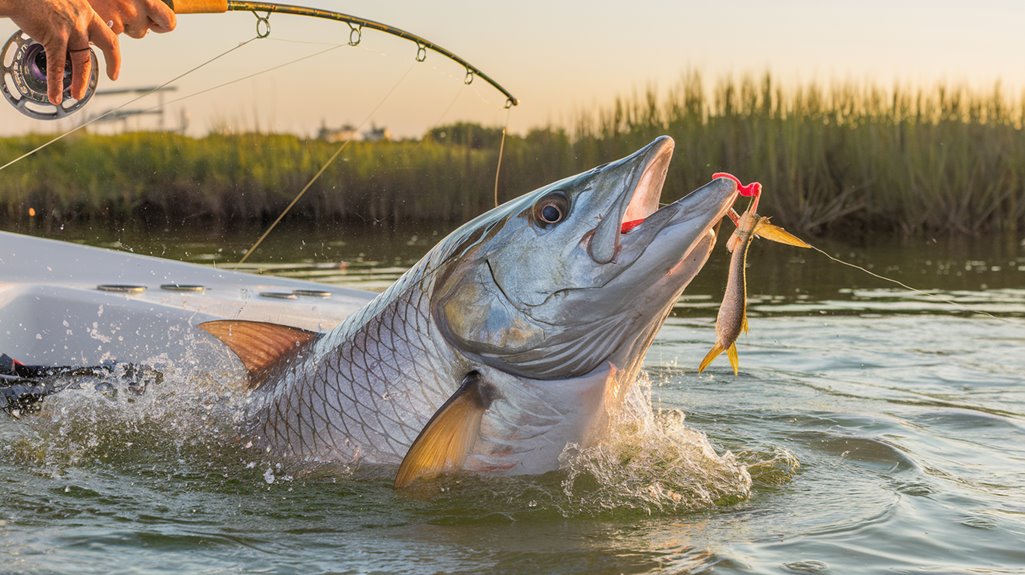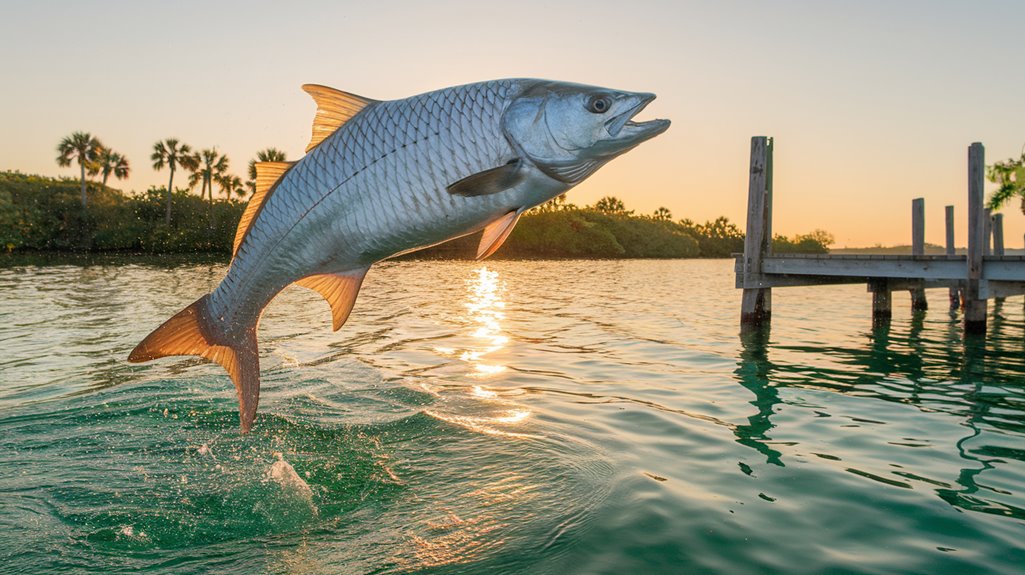Like the ancient mariners who followed the stars to their destiny, you'll find South Carolina's tarpon migration offers a remarkable pursuit along its pristine coastline. From Charleston's bustling harbor to Hilton Head's tranquil waters, you're looking at prime fishing grounds that attract these silver kings between May and October. You'll need specific gear and local knowledge to target these powerful gamefish, and the difference between success and disappointment often comes down to understanding their seasonal patterns.
- Key Takeaways
- Understanding South Carolina's Tarpon Migration Patterns
- Prime Fishing Zones Along the Carolina Coast
- Essential Gear and Equipment for Tarpon Success
- Seasonal Strategies for Landing the Silver King
- Live Bait Techniques and Artificial Lure Selection
- Weather Patterns and Tidal Influences
- Local Regulations and Conservation Practices
- Charter Options and Guide Services
- Frequently Asked Questions
- Conclusion
Key Takeaways
- Charleston's inlet-rich waters provide excellent tarpon fishing opportunities during peak migration months from May through August.
- Port Royal Sound near Hilton Head Island and Beaufort serves as a major migration corridor for trophy-sized tarpon.
- North and South forks of Edisto River around Edisto Island offer prime tarpon fishing spots with consistent activity.
- Winyah Bay near Georgetown attracts large schools of tarpon during late summer and fall months.
- Best fishing locations feature areas where baitfish concentrate, particularly around inlets and estuaries during tide changes.
Understanding South Carolina's Tarpon Migration Patterns
When South Carolina's coastal waters warm up in late spring, tarpon begin their annual migration from Florida and the Gulf of Mexico, creating prime fishing opportunities from May through October. You'll find these magnificent fish following warm currents and abundant food sources along the South Carolina coast, particularly in nearshore waters and estuarine environments. During peak migration months, tarpon congregate in popular fishing spots like Charleston, adapting seamlessly to both saltwater and brackish conditions as they move through the region. Their migration patterns from May to June are heavily influenced by baitfish movements and local environmental factors, making it essential to track these conditions for successful targeting. Understanding these seasonal movements will help you pinpoint prime fishing locations throughout the coastal waters.
Prime Fishing Zones Along the Carolina Coast
Along South Carolina's diverse coastline, several prime zones stand out as tarpon fishing hotspots for anglers seeking trophy catches. During the summer months, you'll find exceptional fishing opportunities from Charleston's inlet-rich waters to Georgetown's productive Winyah Bay. The coastal area's unique geography creates perfect conditions for these migratory fish.
- Charleston's wrecks and inlets host abundant tarpon populations, peaking during summer
- Hilton Head Island and Beaufort share access to Port Royal Sound, an essential migration corridor
- Edisto Island offers prime fishing in both North and South forks of the Edisto River from May through October
- Winyah Bay near Georgetown attracts large schools during late summer and fall, with aggressive feeding patterns
These locations consistently produce trophy-class tarpon for well-prepared anglers targeting specific zones during peak seasons.
Essential Gear and Equipment for Tarpon Success
Successful tarpon fishing in South Carolina's prime locations demands specialized equipment that matches these powerful gamefish. You'll need a 7-8 foot heavy-duty rod with medium-heavy to heavy action, paired with a reel featuring a strong drag system. For Charleston fishing success, use braided line for superior strength and sensitivity, coupled with a fluorocarbon leader in clear waters.
| Equipment | Specification | Purpose |
|---|---|---|
| Rod | 7-8 ft Heavy | Power & Control |
| Line | Braided/Mono | Strength & Feel |
| Leader | Fluorocarbon | Low Visibility |
| Hooks | Circle Hooks | Safe Release |
When targeting tarpon in local waters, stock your tackle box with circle hooks for catch-and-release fishing. For bait, you've got options: live mullet, menhaden, and blue crabs work well, while topwater plugs can trigger explosive surface strikes.
Seasonal Strategies for Landing the Silver King
Understanding South Carolina's tarpon migration patterns is essential for planning your fishing success. You'll find peak action during summer months from May through August, particularly in prime fishing spots like Charleston, Hilton Head Island, and Winyah Bay. Focus your efforts during early morning or late afternoon when tarpon are most active.
- Use heavy-duty gear with braided line and circle hooks to handle powerful runs
- Adapt your technique between live bait drifting and artificial lures based on conditions
- Target areas where baitfish and shrimp concentrate, especially during tide changes
- Time your trips around seasonal migration patterns, focusing on late spring through summer
For ideal results, match your seasonal strategies to the tarpon's feeding habits and movement patterns. Whether you're fishing Charleston's waters or Winyah Bay's productive zones, staying aligned with these patterns greatly improves your chances of success.
Live Bait Techniques and Artificial Lure Selection

When targeting South Carolina's tarpon, your choice between live bait and artificial lures can make or break your fishing success. For live bait fishing, you'll want to rig mullet, menhaden, or blue crabs with circle hooks and floats, allowing them to drift naturally in the current. These baits mimic the natural prey that local tarpon actively pursue.
If you're using artificial lures, opt for brightly colored soft plastics or topwater plugs, especially effective in South Carolina's often murky coastal waters. Vary your retrieval speeds and keep casting persistently to entice these selective predators. For fly fishing enthusiasts, large streamers and baitfish patterns paired with heavy leaders will withstand the powerful runs typical of tarpon fishing. Remember, your fishing techniques should always adapt to the conditions and the tarpon's feeding patterns.
Weather Patterns and Tidal Influences
South Carolina's tarpon fishing productivity hinges heavily on both weather patterns and tidal movements throughout the season. You'll find these magnificent fish most active during warmer waters of late spring and summer when baitfish are abundant. Understanding local tidal charts is essential for timing your trips during peak activity times, particularly during incoming tides and outgoing flows.
- Target brackish waters during early morning and late afternoon hours when feeding behavior is most aggressive
- Monitor weather patterns closely, as rainfall can create ideal salinity levels in estuaries
- Plan your fishing periods around tide changes when tarpon follow baitfish into shallower waters
- Track water temperatures, as they directly influence tarpon movement and feeding patterns
Your success rate will greatly improve by aligning your fishing strategy with these natural cycles and understanding how they affect tarpon behavior in South Carolina's waters.
Local Regulations and Conservation Practices
You'll need a South Carolina fishing license and must adhere to the 77-inch size limit when targeting tarpon, with a strict one-fish daily bag limit per angler. When releasing these prized gamefish, you're required to keep them in the water while removing hooks and guarantee proper oxygenation by moving them forward to force water through their gills. Your tackle setup must be sturdy enough to minimize fight times, as extended battles can fatigue tarpon beyond recovery, making circle hooks and heavy-duty release tools essential components of your conservation-minded gear.
Daily Catch Limits
To protect the sustainability of tarpon populations, South Carolina enforces strict daily catch limits and conservation measures for anglers. You'll need to follow the catch-and-release policy while adhering to specific regulations, including maintaining a bag limit of one tarpon per person. Before targeting these migratory species, verify you've obtained your fishing license if you're over 16 years old.
- You must release all tarpon under 77 inches, measured from snout to tail fork, protecting juvenile fish
- Practice proper handling techniques by keeping water flowing over the gills during release
- Release your catch quickly to minimize stress on these powerful game fish
- Document your catches according to state guidelines, helping conservation efforts track population health
Experienced anglers understand these measures guarantee healthy tarpon populations for future generations while maintaining South Carolina's premier fishing opportunities.
Proper Release Methods
When releasing tarpon in South Carolina waters, proper handling techniques are critical for guaranteeing these magnificent game fish survive and thrive. You'll need to follow the state's strict catch-and-release regulations while minimizing handling time to reduce stress on these migratory giants. Using circle hooks is essential for responsible fishing practices, as they greatly decrease the likelihood of internal injuries during your catch.
Before release, you must guarantee proper water flow through the tarpon's gills to aid recovery. Keep the fish in the water whenever possible, and when you're ready to release, support it upright until it shows signs of strength. Remember, South Carolina's tarpon population depends on anglers like you following these proper release methods, contributing to the long-term conservation of this prized species.
Special Equipment Requirements
Before heading out to chase South Carolina's legendary tarpon, anglers must equip themselves with state-mandated gear and licenses. You'll need your fishing license if you're over 16, and you'll want to guarantee you're prepared for proper catch-and-release practices to protect the migratory population.
- Heavy-duty rod and reel combinations capable of handling fish up to 77 inches in length
- Non-offset circle hooks to minimize injury and improve hook removal during release
- Large rubber-mesh landing net or sling for proper handling techniques
- Measuring device to verify compliance with size limits
Remember that sustainable fishing practices are essential for conservation efforts in South Carolina waters. Your experience as an angler will be enhanced by following these regulations and using the right equipment to protect these magnificent fish for future generations.
Charter Options and Guide Services
Professional charter services and experienced guides offer your best shot at landing South Carolina's elusive tarpon. You'll find numerous local fishing operations providing both half-day and full-day charter options during peak migration months from May through October. A skilled guide will help you navigate prime fishing conditions while teaching you specialized techniques for targeting these magnificent gamefish.
When selecting guide services, you'll want to book well in advance, particularly during the busy summer season. Your professional guide can adapt fishing methods to match your experience level, whether you prefer live bait drifting, artificial lures, or fly fishing approaches. They'll also share invaluable local fishing knowledge about tarpon patterns and behaviors specific to South Carolina waters, considerably improving your chances of a successful catch.
Frequently Asked Questions
Where Is the Best Place to Go Tarpon Fishing?
You'll find prime tarpon fishing in Charleston's coastal waters, where you can target these fighters near inlets and wrecks during summer months. Port Royal Sound and Winyah Bay offer excellent alternatives.
What Month Is Best for Tarpon Fishing?
You'll find peak tarpon fishing during July and August, when water temperatures hit their sweet spot. These months deliver consistent action as the fish actively feed on abundant baitfish schools.
How Old Is a 100 Pound Tarpon?
You'll find that a 100-pound tarpon is typically 10-12 years old, which is remarkable considering they can live beyond 30 years. You can verify this by examining their scale rings.
What Month Is the Best Fishing in South Carolina?
You'll find peak fishing in South Carolina during July and August, when water temperatures reach their warmest. The abundant baitfish and ideal conditions create excellent opportunities across coastal waters.
Conclusion
Like a skilled conductor leading a symphony, you'll find your tarpon success in South Carolina's waters requires precise timing, expert technique, and intimate knowledge of the coastline. From Charleston's productive flats to Port Royal Sound's deep channels, you're now equipped to pursue these silver monarchs with confidence. Arm yourself with the right gear, respect local regulations, and you'll be ready to execute the perfect coastal crescendo.

